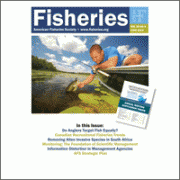Canadian Recreational Fisheries: 35 Years of Social, Biological, and Economic Dynamics from a National Survey
AUTHOR(S): Jacob W. Brownscombe, Shannon D. Bower, William Bowden, Liane Nowell, Jonathan D. Midwood, Neville Johnson, Steven J. Cooke
CITATION:
Brownscombe J.W., S.D. Bower, W. Bowden, L. Nowell, J. D. Midwood, N. Johnson, and S.J. Cooke. 2014. Canadian recreational fisheries: 35 years of social, biological, and economic dynamics from a national survey. Fisheries 39(6):251-260. https://doi.org/10.1080/03632415.2014.915811
ABSTRACT:
Fisheries and Oceans Canada has collected a unique, long-term data set on the social, biological, and economic dynamics of Canada’s recreational fisheries. Starting in 1975, these data were collected through mail surveys to recreational anglers at 5-year intervals. A longitudinal analysis revealed that there was an average of 4.5 million licensed anglers catching an annual average of 255 million fish.
Release rates were relatively high (53% of fish released on average), with recent survey data (2010) suggesting that release rates had exceeded 60%. Recreational anglers also contribute an average of $8.8 billion each year to the Canadian economy. However, recreational angling has become less popular over time, and the average age of participants has increased. The data were also useful for characterizing Canada’s fisheries, including species-specific catch and harvest. Canada is one of the few countries to collect such extensive recreational fisheries data at a national scale and to do so at regular intervals, an approach that could be modeled by other countries.
FULL TEXT – Brownscombe et al.



